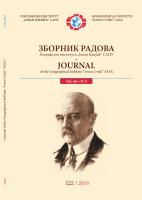At-Site Hydrological Drought Analysis: Case Study Of Velika Morava River At Ljubičevski Most (Serbia)
At-Site Hydrological Drought Analysis: Case Study Of Velika Morava River At Ljubičevski Most (Serbia)
Author(s): Dragoljub Štrbac, Dragan Dolinaj, Marko UroševSubject(s): Geography, Regional studies, Recent History (1900 till today), Environmental interactions
Published by: Географски институт »Јован Цвијић« САНУ
Keywords: hydrological drought; method of threshold level; partial duration series; L-moments; the Velika Morava River;
Summary/Abstract: At-site frequency analysis of hydrological droughts is presented in this paper, in the example of the hydrological station Ljubičevski Most on the Velika Morava River, which represents the outlet of the entire Velika Morava basin, covering 42% of the Republic of Serbia. It is the first time that for the Velika Morava basin, and Serbia, theoretical distributions of deficit and duration of hydrological droughts are chosen according to best fit to empirical data, and not according to chosen in advance distributions, which has been the case until now. Also, for the first time in Serbia the method of L-moments was used for parameter estimation of distributions for extreme value modeling of hydrological drought characteristics. These improvements of existing method should contribute to better estimation of hydrological drought of large return period. The hydrological droughts were selected by threshold level method using daily data for the period 1960–2014, and their characteristics, deficits and durations of droughts were analyzed by method of partial duration series (peak over threshold). The results of calculations indicate that the best fit with the empirical data of deficit volumes has the model with binomial distribution of number of drought occurrences and Weibull distribution of exceedance magnitudes (B+W), and with drought durations model with binomial distribution of number of drought occurrences and exponential distribution of exceedance magnitudes (B+E). Based on the chosen distribution it is possible to calculate exceedance probabilities, i.e. return periods of deficit volumes and durations of largest observed droughts, like the 1993 drought, or to estimate 10-, 20-, 50- and 100-year droughts.
Journal: Зборник радова Географског института "Јован Цвијић" САНУ
- Issue Year: 66/2016
- Issue No: 2
- Page Range: 203-220
- Page Count: 18
- Language: English

